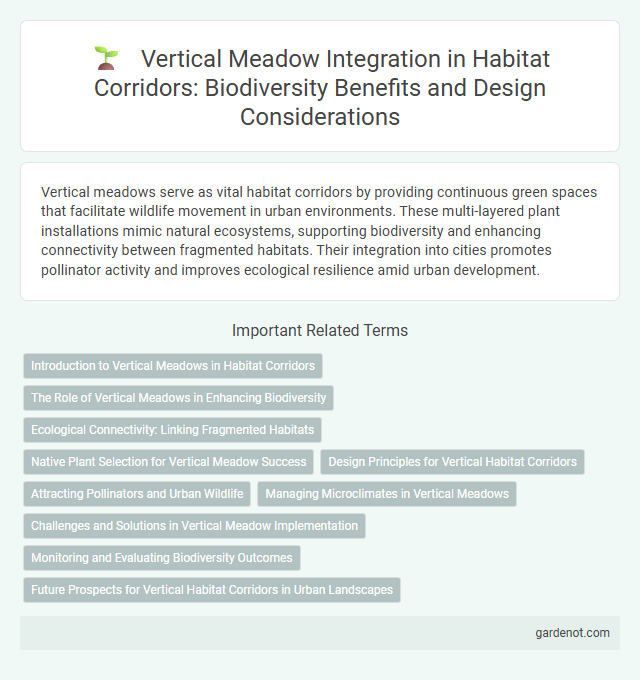Vertical meadows serve as vital habitat corridors by providing continuous green spaces that facilitate wildlife movement in urban environments. These multi-layered plant installations mimic natural ecosystems, supporting biodiversity and enhancing connectivity between fragmented habitats. Their integration into cities promotes pollinator activity and improves ecological resilience amid urban development.
Introduction to Vertical Meadows in Habitat Corridors
Vertical meadows enhance habitat corridors by providing multi-layered vegetation that supports diverse wildlife species and improves ecosystem connectivity. These green structures mimic natural cliff and rock habitats, offering essential resources like food and shelter for pollinators, birds, and small mammals. Integrating vertical meadows into urban and fragmented landscapes promotes biodiversity while mitigating habitat loss and fragmentation.
The Role of Vertical Meadows in Enhancing Biodiversity
Vertical meadows create multi-layered habitats that support diverse flora and fauna, effectively expanding green spaces in urban environments. Their vertical structure introduces varying microclimates and niches, attracting pollinators, birds, and beneficial insects crucial for ecosystem balance. Integrating vertical meadows into habitat corridors strengthens connectivity between fragmented natural areas, promoting species migration and genetic exchange essential for biodiversity resilience.
Ecological Connectivity: Linking Fragmented Habitats
Vertical meadows enhance ecological connectivity by serving as crucial habitat corridors that link fragmented ecosystems, facilitating wildlife movement and gene flow. These green structures mimic natural environments vertically, allowing species to traverse urban and developed areas with reduced risk of isolation. By integrating vertical meadows into city planning, biodiversity is preserved and habitat fragmentation is mitigated effectively.
Native Plant Selection for Vertical Meadow Success
Selecting native plant species such as goldenrod (Solidago spp.), milkweed (Asclepias spp.), and wild columbine (Aquilegia canadensis) enhances vertical meadow success by promoting local biodiversity and supporting pollinators. Native plants are adapted to regional soil, climate, and wildlife, ensuring greater resilience and lower maintenance in vertical garden settings. Incorporating a diverse mix of native perennials and grasses improves habitat connectivity within urban habitat corridors, fostering ecological balance.
Design Principles for Vertical Habitat Corridors
Vertical meadows integrate native plant species to create diverse habitats that support urban biodiversity and pollinators. Design principles emphasize layering vegetation vertically to maximize space, promote species connectivity, and enhance microclimates within dense cityscapes. Structural elements prioritize sustainable materials and water-efficient irrigation systems to ensure ecological resilience and habitat functionality.
Attracting Pollinators and Urban Wildlife
Vertical meadows provide essential habitat corridors by attracting pollinators such as bees, butterflies, and hummingbirds, enhancing urban biodiversity. These green walls offer blooming plants year-round, serving as vital foraging and nesting sites that support the survival of urban wildlife. Integrating vertical meadows in cityscapes strengthens ecological connectivity, promoting pollination and urban ecosystem health.
Managing Microclimates in Vertical Meadows
Managing microclimates in vertical meadows involves optimizing plant selection and placement to regulate temperature, humidity, and sunlight exposure, creating favorable habitats for diverse species. Vertical layering using native vegetation enhances airflow and moisture retention, promoting biodiversity and resilience against extreme weather conditions. Innovative irrigation techniques and shading structures further support microclimate stability, ensuring the vertical meadow thrives year-round within habitat corridors.
Challenges and Solutions in Vertical Meadow Implementation
Vertical meadows face challenges such as limited soil depth, water retention difficulties, and structural load constraints on urban buildings. Solutions involve utilizing lightweight, high-drainage substrates, integrating efficient irrigation systems like drip or hydroponic setups, and enhancing structural support through advanced engineering techniques. Implementing native, drought-resistant plant species further optimizes vertical meadow sustainability and biodiversity.
Monitoring and Evaluating Biodiversity Outcomes
Vertical meadows serve as critical habitat corridors by supporting diverse plant and insect species within urban environments, facilitating connectivity between fragmented green spaces. Monitoring methods include bioacoustic sensors and remote cameras to track species presence, abundance, and behavior over time. Evaluating biodiversity outcomes relies on metrics such as species richness, pollinator visitation rates, and vegetation health indices to assess the ecological effectiveness of vertical meadow installations.
Future Prospects for Vertical Habitat Corridors in Urban Landscapes
Vertical meadows represent a transformative approach to urban habitat corridors by integrating native plant species on building facades, enhancing biodiversity and ecological connectivity in metropolitan areas. Advances in green infrastructure technology and increased urban sustainability initiatives are set to expand the adoption of vertical habitat corridors, promoting pollinator habitats and mitigating the urban heat island effect. Future prospects highlight the role of vertical meadows in improving air quality, supporting wildlife movement, and fostering resilient ecosystems within densely populated cities.
Vertical meadow Infographic

 gardenot.com
gardenot.com